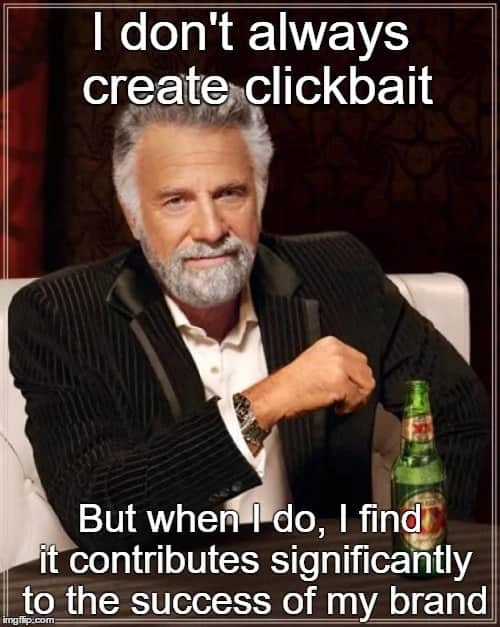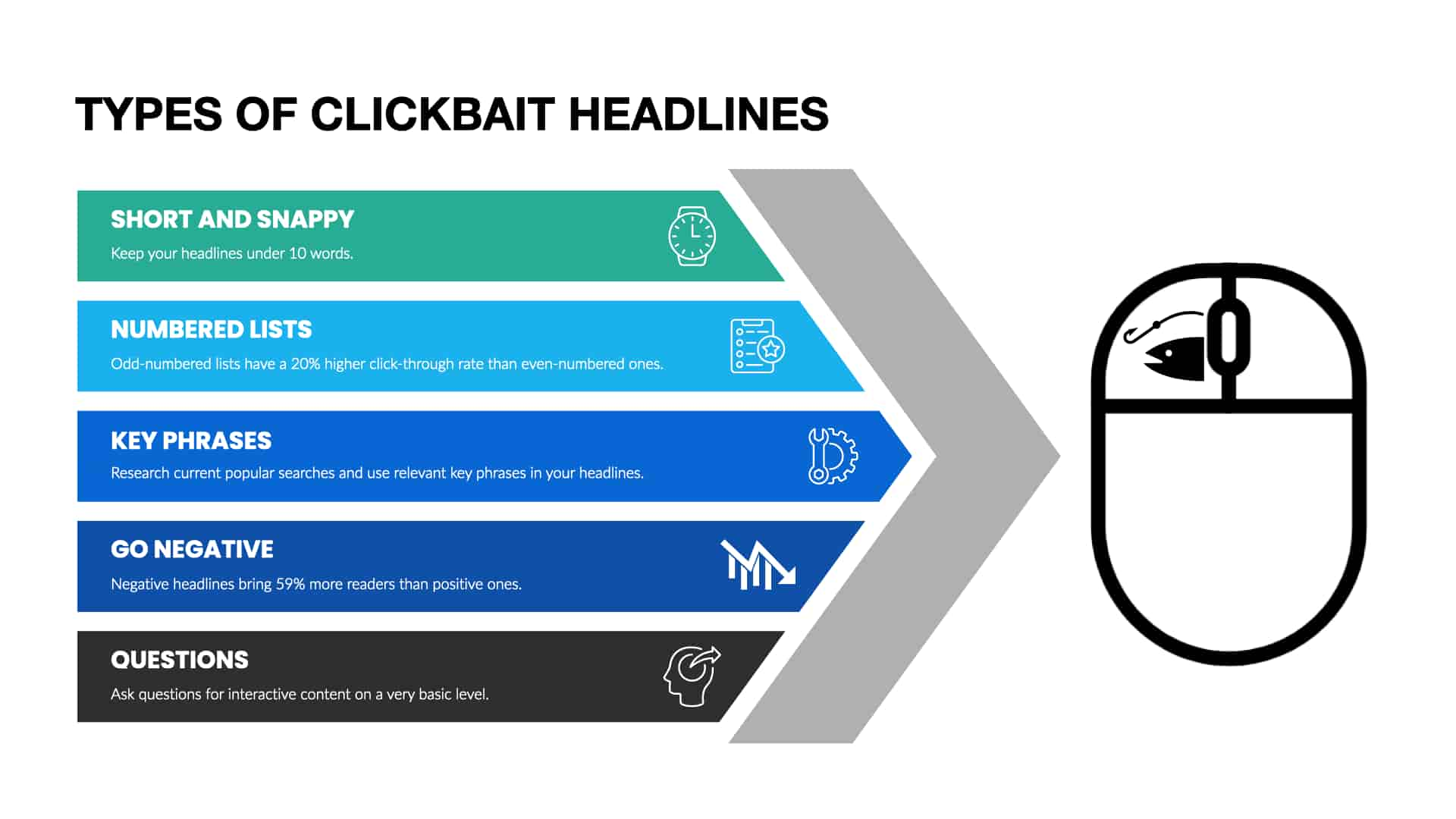Clickbait Examples: Powerful Headlines and Images Drive Clicks
90% of the traffic your articles draw will be because of the headline – not the content that follows.
This is because few will see the content that follows unless the headline is good. That is where “clickbait” headlines come in. A highly clickable headline will help content get more views, and rise in search results, and is, therefore, a tool used in marketing, public relations, and modern reputation management practices.Many people use clickbait headlines like “How I Made $1 Million Last Week From Clicking Here” or “What Happened When I Clicked Here And Asked Her On A Date.”Clickbait headlines are attention-grabbers and keep people intrigued with curiosity. They are short, tempting readers to click on them. And in today’s attention-starved online world that is full of competing content vying for our views, this is exactly what you need to stand out.Try it for yourself. You’ll be surprised at the results.But never overdo it and always make sure you deliver on what your headline promises.
We’re in a hurry, so we skim
Search engines demonstrate this principle in action: We enter a search term and receive instant results, often numbering in the thousands or millions. And our eyes skim the results from the top, zeroing in on page titles and skimming descriptions of those titles that interest us. It’s human nature to assess an environment quickly and take in key information at a glance. This is true whether the environment is wilderness or Web page.It’s important to keep this in mind when trying to attract hits. If a potential reader is going to click, the title and description must be compelling. They must signal to readers that the page has what they are looking for. What you’re after is a strong click-through rate. A can’t-pass-up web feature is sometimes referred to as clickbait. We click almost unwillingly, sometimes putting everything else on hold. The very best strategy is to combine baited headlines with high-quality online content as we build our brands. Clickbait headlines are, to an extent, a big part of reputation campaigns.
A can’t-pass-up web feature is sometimes referred to as clickbait. We click almost unwillingly, sometimes putting everything else on hold. The very best strategy is to combine baited headlines with high-quality online content as we build our brands. Clickbait headlines are, to an extent, a big part of reputation campaigns.
The importance of headlines
Compelling headlines tease readers with content that they won’t want to resist.
Clickbait examples
Here are a few examples of how clickbait is structured:
- Why We Love ___________ – This is an example of a tried and true clickbait headline. The “Why we love…” headline tantalizes the reader but doesn’t satisfy their desire to know – at least until they click… and that’s the point.
- __ Secret Tips – Numbers are a good way to get people to click. The idea of a quick and easy list of tips draws people in very effectively.
- How To Solve ___________ – First, it poses something as a problem. Then it *almost* proposes a solution. But in order to get the solution, you have to click – insidious.
- A List Of Best _________ – This is the “curation” model of clickbait. It makes it seem like someone has gone to the trouble of researching a long list of possibilities and providing the reader with a shortlist of the best. In reality, these lists are usually sponsored by someone – usually someone in the #1 position on the list.
- The Best/Worst… – Dramatic! Black and white! It doesn’t answer the question, it just provides a dramatic counterpoint. Enticing!
- The Ultimate Guide to _______ – Who doesn’t want the “ultimate” guide? The internet is stuffed with information; we all want the best or ultimate. So the ultimate guide to something must be the best… right?
Images matter
A solid headline and snippet (or search engine description) is only half of the battle – but it’s the first half. Articles need enticing images to hold a reader’s attention. But bear in mind, not just any clipart will suffice. Art should be used with purpose.Users ignore images that don’t provide relevant information. Before using images on a website, we should ask ourselves some key questions:Is the image relevant? Is it of good quality? Does it have an emotional appeal? What message does it send?The best images are unique to your page, perhaps custom provided—but at the very least, not stock art that can be found on numerous similar sites.
People like people
Studies of photos on Instagram reveal that photos featuring faces get 38% more likes and 32% more comments than photos of objects. When you have the option, have strong and relevant images accompany your articles. A baited or catchy headline can catch a reader, but compelling images help to hold them once they’re in.
Further reading
Learn more about how to create compelling web content here.
Clickbait FAQs
What is clickbait?
Clickbait is a headline that is built on the sensational nature of your material that’s impossible to ignore. Headlines from click-fueled publications like Business Insider, Buzzfeed, and the Gawker Media family often have little to do with the actual content of their stories.
Why do people click on clickbait headlines?
Clickbait headlines compel readers to click them because they create a feeling of disequilibrium. This means that once a person reads it, they are unfulfilled and curious, so they click the link to satisfy that. It is important to resist creating clickbait headlines that aren’t related to your article. The headline must be on-topic to avoid a high bounce rate, which will hurt your SEO.
How can I write more clickable headlines?
Here are some tried and true examples of creating clickbait. Keep them brief. Use a number. Ask a question. Go negative. Use key phrases to lure readers. Familiar varieties include top ten lists, fact pieces, interviews, and many other familiar tropes.
About the author
Kent Campbell is the chief strategist for Reputation X, an award-winning online reputation management agency. He has over 15 years of experience with SEO, Wikipedia editing, review management, and online reputation strategy. Kent has helped celebrities, leaders, executives, and marketing professionals improve the way they are seen online. Kent writes about reputation, SEO, Wikipedia, and PR-related topics. –
Tags: SEO.
